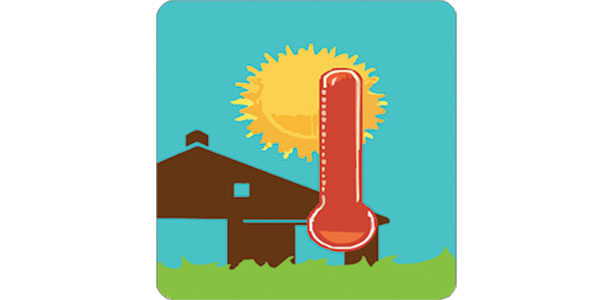As the temperatures reach beyond heat stress levels in July, now is the time to locate areas on your dairy where heat stress is affecting your herd and where heat abatement is needed.
Detect and evaluate heat-stress levels
The simplest way to detect heat stress is by observing your cows. In a given area, if the majority of your herd is standing, as opposed to lying and ruminating, this is the first indication they may be experiencing heat stress.
Studies indicate that when animals get uncomfortable – around 68ºF – they stand up to help heat escape from their body by allowing air to circulate around them. A quick respiration count can determine a particular animal’s heat-stress level.
The threshold begins at 60 breaths per minute (BPM), and as the core body temperature elevates, mild to moderate heat-stress respiration will be around 75 BPM. Moderate to severe stress is when respiration begins to exceed 85 BPM, and severe heat stress sets in when BPM exceed 120.
Rectal temperature also measures the animal’s heat-stress level. The starting point is 101.3ºF, with mild to moderate stress occurring at 102.2ºF. Severe stress begins at 104ºF, but by the time temperatures reach 106ºF, death can occur as a result of heat stress.
For a more sophisticated way to determine heat stress, there are several heat stress applications that can be downloaded to your smartphone. These applications put the tools you need in your hands and at your fingertips, giving you the flexibility to look for areas of concern and evaluate heat stress in real-time.
The University of Guelph (Canada), the Ontario Ministry of Agriculture, Food and Rural Affairs created an app you can download free from Google Play or the Blackberry Market Place. Appropriately named Heat Stress, this app works for several livestock applications, from swine to goats, and it is relatively simple to operate. The app is available in three languages: English, French and Spanish.
To use Heat Stress, click on the app and select the livestock species of your choice. For this example, we will select “dairy.” You will then be prompted to select a housing style: freestall or tiestall. If you tap “Free Stall,” a display of seven temperatures in both Celsius and Fahrenheit will be displayed.
Simply touch your screen and select the temperature closest to your barn, or better yet, exactly where your dairy cow is standing. Let’s say it is 82ºF; the screen also indicates 28ºC. Once you select that temperature, you will then need to select the relative humidity.
Again, the most accurate percentage of humidity for that exact location will yield a better result as to the true THI. In our example, we pick 70 percent, but the THI choices range from as low as 40 percent to as high as 100 percent. (Note: Use the arrows to move ahead or back from screen to screen.)
Once you have selected both the temperature and humidity, the app will automatically give you the THI. In our case, a THI of 78 is indicated. A color-coded bar graph on the right indicates the severity from blue to red. Blue meaning no heat stress or little heat stress is being detected, while red warns that severe heat stress is detected.
Below, the alert relief actions are given. For our example, ventilation with panel fans or tunnel ventilation needs to be activated, and the feed-line soaking systems need to operate for one to two minutes every 15 minutes. It also reminds you to have fresh water access for your animals.
This information is only helpful if you use it. Do some research and find the application or system that works best for you. Review each of the applications as well as other applications that may have evolved or have been recently created.
Technology is ever-changing and improving. Implement the one that works for you in your heat-abatement plan. Make sure you evaluate all locations on your dairy, breaking down groups or areas that may have been forgotten.
Why cool dry cows and calves?
Recent studies conducted by the University of Florida have shown the effects of heat stress on dry cows and calves. Dry cows, specifically, are an example of a group on many dairies that has been neglected when it comes to proper heat abatement and evaluation of heat-stress levels.
These studies, however, go into detail on how heat stress during the dry period affects hepatic gene expression and adipose tissue mobilization during the transition period. The valuable conclusion is that cooling heat-stressed dry cows can increase milk production in subsequent lactations, therefore justifying the importance of investing in cooling methods for these often-forgotten cows.
A second study by the University of Florida concludes that heat stress significantly impacts dry cow health and productivity in both the prepartum and postpartum periods. Mammary gland development, compromised placental development, fetal development and immune competence of calves can all be affected in a negative fashion if heat stress is not addressed.
By using tools like the heat stress apps, you can identify areas on the dairy where heat abatement is needed and then visit with ventilation experts who can provide products that have been tested to eliminate some of the heat build-up.
Hospitals, birthing areas and newborn pens are also locations where heat stress needs to be assessed. While you may have cooling in these areas, don’t forget to look for hot spots and make sure the methods are effective.
With the new technology and the correct application, you can yield excellent return on your investments. Applying the new technology in your most critical areas will allow you to move some of the older technology to low-impact areas. This allows you to make improvements to your heat abatement strategy while at the same time utilizing some older technology to still yield some return in those non-critical areas.
Even though the summer heat is upon us, it is never too late to make changes to reduce heat stress and improve your herd’s health and output. The basic availability of fresh water and shade are the starting points for heat abatement, and taking a step further by adding the correct air movement and soaking can help you add more back to the bottom line. Just remember, mild heat stress begins at 68ºF, so when you walk through a location on your dairy, it is not the temperature that feels comfortable to you that counts. It is what is best for your dairy cattle.PD
James Kleinke
Schaefer Fan






